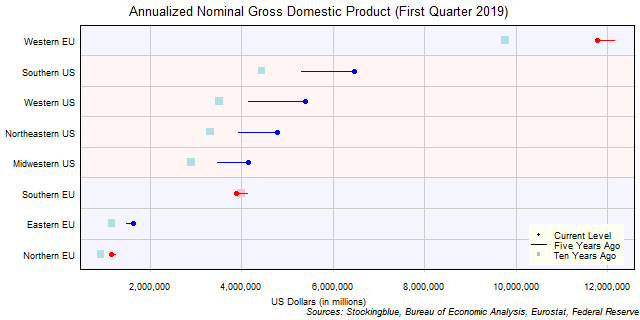
The chart above shows the annualized nominal gross domestic product (GDP) in each EU and US region as of the first quarter of 2019 in millions of US dollars, the change from five years ago, and the GDP ten years prior. The Southern and Western US and the Western EU each grew by more over the past ten years than the entire GDP of the Eastern EU. Additionally, all four US regions and the Western EU each had an improvement in their GDP over the past ten years that is larger than the entire GDP of the Northern EU.
Findings
- The difference between the region with the largest GDP, the Western EU, and the region with the smallest, the Northern EU, is $10,619,077.20 million (down from $10,907,376.66 million five years ago and up from $8,835,972.08 million ten years ago). The Western and Northern EU had the largest and smallest GDP respectively both five and ten years ago.
- The Western EU has 10.14 times the GDP that the Northern EU does. The ratio of largest GDP to smallest GDP went up from 9.77 five years ago and down from 10.48 ten years ago.
- Five regions (one EU, four US) saw their GDP rise in current dollars over the past five years while three (all from the EU) saw it drop.
- Seven regions (three EU, four US) saw their GDP rise in current dollars over the past ten years while one (from the EU) saw it drop.
- All EU drops in GDP are attributed to currency rate fluctuations.
Caveats
- Data is from the first quarters of 2019, 2014, and 2009.
- The data is seasonally adjusted in current dollars.
- Euros are converted to dollars at an average exchange rate of 1.14 for the first quarter of 2019, 1.37 for the first quarter of 2014, and 1.30 for the first quarter of 2009 according to historic rates listed at the Federal Reserve (see source link below).
- US data comes in an annualized format which the EU does not, thus EU data is annualized by multiplying the quarterly figure by four.
- US growth rates may differ from those provided by the Bureau of Economic Analysis as the BEA's growth rates are based on chained dollars in conjunction with the chain index or the quality index for real GDP. The growth rates listed here are based on nominal GDP.
- All figures are rounded to the nearest hundredth.
- The Western EU consists of Germany, United Kingdom, France, Netherlands, Belgium, Austria, Ireland, and Luxembourg.
- The Southern US consists of Texas, Florida, Georgia, North Carolina, Virginia, Tennessee, Louisiana, South Carolina, Alabama, Kentucky, Oklahoma, Arkansas, Mississippi, and West Virginia.
- The Western US consists of California, Washington, Colorado, Arizona, Oregon, Utah, Nevada, New Mexico, Hawaii, Idaho, Alaska, Montana, and Wyoming.
- The Northeastern US consists of New York, Pennsylvania, New Jersey, Massachusetts, Maryland, Connecticut, New Hampshire, Delaware, Maine, Rhode Island, and Vermont.
- The Midwestern US consists of Illinois, Ohio, Michigan, Indiana, Minnesota, Wisconsin, Missouri, Iowa, Kansas, Nebraska, North Dakota, and South Dakota.
- The Southern EU consists of Italy, Spain, Portugal, Greece, Cyprus, and Malta.
- The Eastern EU consists of Poland, Czech Republic, Romania, Hungary, Slovakia, Bulgaria, Croatia, Slovenia, Lithuania, Latvia, and Estonia.
- The Northern EU consists of Sweden, Denmark, and Finland.
Details
In absolute terms, the Western EU saw the largest decrease over the past five years with a drop of $370,971.72 million. The Western US had the largest growth with a gain of $1,234,498.00 million. Over the past ten years, the Southern EU had the largest decrease with a drop of $105,203.69 million while the Southern US had the greatest increase with a gain of $2,031,777.30 million.
In relative terms, the Northern EU had the largest decrease over the past five years with a 6.65% drop in GDP while the Western US had the greatest increase with a 29.66% rise in GDP. Over the past ten years, the Southern EU had the largest decrease with a 2.63% drop in GDP while the Western US had the largest growth with a 53.26% rise in GDP.
There was one region with a GDP of over $5,000,000 million ten years ago, two regions five years ago, and three regions now. On the flip side, there were three regions with a GDP of less than $3,000,000 million ten years ago, two regions five years ago, and two regions now.
Both the Northeastern and Midwestern US overtook the Southern EU over the past five years. Over the past ten years the Southern EU was surpassed by the Western, Northeastern, and Midwestern US.
Sources
Eurostat. 2019. "GDP and Main Components." Accessed August 19, 2019. https://appsso.eurostat.ec.europa.eu/nui/show.do?query=BOOKMARK_DS-406779_QID_-64A128D_UID_-3F171EB0&layout=TIME,C,X,0;GEO,L,Y,0;UNIT,L,Z,0;S_ADJ,L,Z,1;NA_ITEM,L,Z,2;INDICATORS,C,Z,3;&zSelection=DS-406779UNIT,CP_MEUR;DS-406779INDICATORS,OBS_FLAG;DS-406779S_ADJ,SCA;DS-406779NA_ITEM,B1GQ;&rankName1=UNIT_1_2_-1_2&rankName2=INDICATORS_1_2_-1_2&rankName3=NA-ITEM_1_2_-1_2&rankName4=S-ADJ_1_2_-1_2&rankName5=TIME_1_0_0_0&rankName6=GEO_1_2_0_1&sortC=ASC_-1_FIRST&rStp=&cStp=&rDCh=&cDCh=&rDM=true&cDM=true&footnes=false&empty=false&wai=false&time_mode=NONE&time_most_recent=false&lang=EN&cfo=%23%23%23%2C%23%23%23.%23%23%23.
Federal Reserve. 2019. "Foreign Exchange Rates." Accessed September 26, 2019. https://www.federalreserve.gov/releases/g5/.
US Bureau of Economic Analysis. 2019. "GDP by State." Accessed August 18, 2019. https://www.bea.gov/data/gdp/gdp-state.